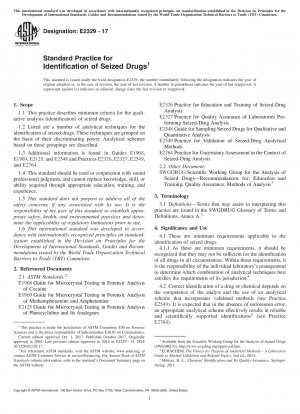ASTM E2329-17
Standard Practice for Identification of Seized Drugs
- Standard No.
- ASTM E2329-17
- Release Date
- 2017
- Published By
- American Society for Testing and Materials (ASTM)
- Latest
- ASTM E2329-17
- Scope
-
4.1 These are minimum requirements applicable to the identification of seized drugs.
4.1.1 As these are minimum requirements, it should be recognized that they may not be sufficient for the identification of all drugs in all circumstances. Within these requirements, it is the responsibility of the individual laboratory’s management to determine which combination of analytical techniques best satisfies the requirements of its jurisdiction.4
4.2 Correct identification of a drug or chemical depends on the competence of the analyst and the use of an analytical scheme that incorporates validated methods (see Practice E2549). It is expected that in the absence of unforeseen error, an appropriate analytical scheme effectively results in reliable and scientifically supported identifications5 (see Practice E2764).
4.3 This practice requires the laboratory’s analytical scheme to incorporate techniques that operate on significantly different principles. It does not discourage the use of any particular method within an analytical scheme. Actual practices followed by a particular laboratory may depend upon jurisdictional requirements.
1.1 This practice describes minimum criteria for the qualitative analysis (identification) of seized drugs.
1.2 Listed are a number of analytical techniques for the identification of seized drugs. These techniques are grouped on the basis of their discriminating power. Analytical schemes based on these groupings are described.
1.3 Additional information is found in Guides E1968, E1969, E2125, and E2548 and Practices E2326, E2327, E2549, and E2764.
1.4 This standard should be used in conjunction with sound professional judgment, and cannot replace knowledge, skill, or ability acquired through appropriate education, training, and experience.
1.5 This standard does not purport to address all of the safety concerns, if any, associated with its use. It is the responsibility of the user of this standard to establish appropriate safety, health, and environmental practices and determine the applicability of regulatory limitations prior to use.
1.6 This international standard was developed in accordance with internationally recognized principles on standardization established in the Decision on Principles for the Development of International Standards, Guides and Recommendations issued by the World Trade Organization Technical Barriers to Trade (TBT) Committee.
ASTM E2329-17 Referenced Document
- ASTM E1968 Standard Guide for Microcrystal Testing in the Forensic Analysis of Cocaine
- ASTM E1969 Standard Guide for Microcrystal Testing in the Forensic Analysis of Methamphetamine and Amphetamine
- ASTM E2125 Standard Practice for Microcrystal Testing in Forensic Analysis for Phencyclidine and Its Analogues*, 2019-11-01 Update
- ASTM E2326 Standard Practice for Education and Training of Seized-Drug Analysts*, 2024-04-21 Update
- ASTM E2327 Standard Practice for Quality Assurance of Laboratories Performing Seized-Drug Analysis*, 2024-04-21 Update
- ASTM E2548 Standard Guide for Sampling Seized Drugs for Qualitative and Quantitative Analysis*, 2024-04-21 Update
- ASTM E2549 Standard Practice for Validation of Seized-Drug Analytical Methods*, 2024-04-21 Update
- ASTM E2764 Standard Practice for Uncertainty Assessment in the Context of Seized-Drug Analysis*, 2024-04-21 Update
ASTM E2329-17 history
- 2017 ASTM E2329-17 Standard Practice for Identification of Seized Drugs
- 2014 ASTM E2329-14 Standard Practice for Identification of Seized Drugs
- 2010 ASTM E2329-10 Standard Practice for Identification of Seized Drugs
- 2009 ASTM E2329-09 Standard Practice for Identification of Seized Drugs
- 2004 ASTM E2329-04 Standard Practice for Identification of Seized Drugs
